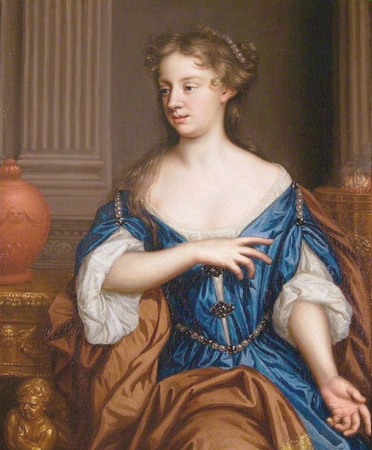Mary Beale and her family
The artist Mary Beale and her husband, Charles, provided lodgings for the Revd Samuel Woodforde after the death of his father, and at a time when he was dependent financially upon his mother's family whose insistence on matters such as matrimony caused disagreements. Through his association with the Beales, Samuel met Alicia Beale. They married in 1661. The Woodforde family of Ansford descends from their son, Heighes Woodforde.



Mary Beale was born in the rectory of the parish of Barrow in West Suffolk, and was baptised on 26 March 1633 by her father, the Revd John Cradock, in All Saint's Church where he was the rector. She married Charles Beale. They set up home in Covent Garden, London.
Charles Beale became deputy clerk of the patents office in about 1660, by which time Mary had begun to practise as a portrait artist. In 1664, they moved to Albrook in Hampshire, and it was there that Mary wrote her Discourse of Friendship. In 1670 the family returned to London and she set up a studio in Pall Mall.
Her subjects included members of the gentry and aristocracy as well as eminent clergymen such as Edward Stillingfleet, Gilbert Burnet, and John Tillotson. She also painted portraits of herself and her family. Her work was supported by her husband who managed the financial side of her business and sourced materials for her. Their son Charles trained as an artist in her studio.
Sir Peter Lely, the leading court painter of the day, visited her studio and commended her work. She later studied his techniques and made much of her living from producing copies of his portraits.
Both Mary and her husband Charles were brought up in Puritan households and seem to have retained this stance throughout their lives. Samuel Woodforde had been brought up in a strongly puritan household but had chosen to enter the church and accept seemingly high church traditions.
Mary was one of the most successful British portrait painters of the late 17th century and, with Joan Carlile (c.1606 -1679) and Susan Penelope Rosse (c.1655-1700) was part of a small but significant group of female professional artists working in London.
She died in London on 8 October 1699 and was buried beneath the communion table at St James, Piccadilly.
Alicia Beale (1638-1663/4)
During the summer of 1659, Thomas Flatman, whom Samuel had met at the Inner Temple as a fellow student, introduced him to the Beale family. Samuel later lodged with Charles and Mary Beale for several years at their large residence in Hind Court near Fleet Street in London.
He became acquainted with Alicia Beale, the daughter of the Revd Theodore Beale and a niece of Charles Beale. They married on 10th October 1661 at St Christopher le Stocks, London, after Samuel had finally obtained the approval of his mother's family who had supported him financially following his father's death in 1654.
In 1662, a daughter, Alice, was born, followed by a son, Heighes, on 9th January 1663/4. Alice died on 14 January from post-delivery sepsis. Their daughter married the Revd Alexander Dalgress (1660-1722), the rector of Farringdon, Hants. They had one son, William, who was born in 1694 and who married Mary Street.
A previously unknown portrait by Mary Beale was exhibited in London in 2019 at the London gallery of Lyon & Turnbull. The sitter is now thought to be Samuel Woodforde. It was painted in the 1660s when the artist created a series of 'friendship portraits' but the attribution to Beale was lost, and it was more recently thought to be by Lely. The date of this portrait suggests that Samuel had stayed close to the Beale family after Alice's death. Samuel's diary for this period shows that he entered a long period of grieving for Alice:
"I, Samuel, eldest son of Robert, grandson of Robert, and great grandson of Edward, of Old, being about 25 years of age, was married to Alicia, youngest daughter of Mrs. Elizabeth Beale, widow of Theodore Beale, B.D. of the county of Bucks, (a zealous adherent of the royal family of Stuart,) of the ancient family of the Beales of Beverly, in Yorkshire, aged about 27, at St. Christopher's, behind the Exchange, London, upon Thursday, 10th of October, 1661, by my cousin Tillotson, (the celebrated Archbishop of Canterbury,) and by her, through the blessing of God, have had issue, Alicia, born in London (married to the Rev. Alexander Dalgress, rector of Farringdon, Hants); Heighes, born at Bensted, in the county of Southampton, but then though I became the joyful father of a son, I was in a few days deprived of my dearest wife, whom my God was pleased, by a violent fever, to take out of this miserable life unto himself, upon Thursday, January 14th; we had lived by His infinite mercy, in the bands of holy wedlock, 2 years, 3 months, and 4 days, in the opinion of all, I believe even our enemies, as happy and loving a pair as ever came together, blessed be our good God: she was the Saturday following buried in Heighes chancel, in the very place where my great grandmother, my Lady Heighes, about 37 years before was buried, whose silk stockings (all else but the bones in them being quite wasted) remained entire and without the least rottenness, as many in my parish said who saw them. Oh my God, sanctify this so great visitation to me I humbly beseech thee, for my Saviour's Sake Christ Jesus, Amen."

A Paraphrase upon the Psalms of David
It was while lodging with the Beale family that Samuel wrote his A Paraphrase upon the Psalms of David which was published in 1668 by Octavious Pullen and printed 'near the Pump in Little Britain' in the vicinity of St Paul's churchyard, a short distance from Hind Court. Samuel included versions by Mary Beale of four psalms (Nos 13,
52, 70 and 130).
